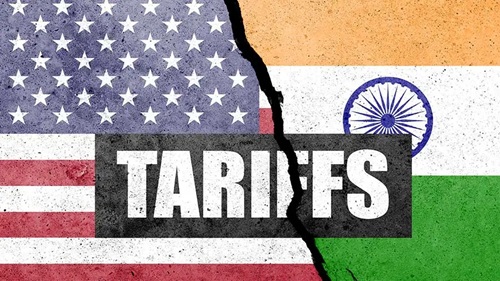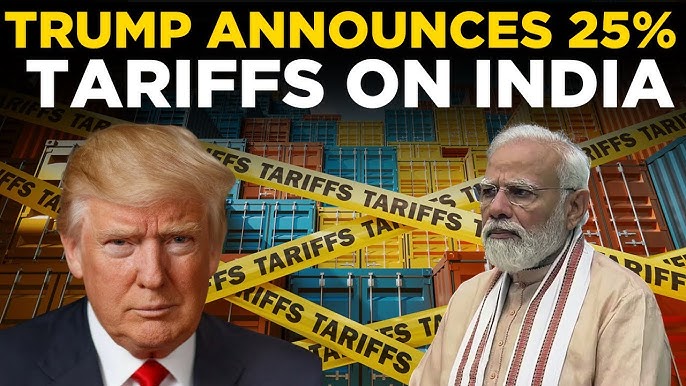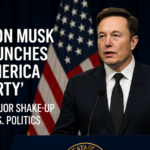Imagine waking up one morning to find the price of your favorite Indian products in the US skyrocketing by 25%. That’s no longer hypothetical, this could be India’s reality after former U.S. President Donald Trump announced a proposed 25% tariff on a broad spectrum of Indian exports. With his eyes potentially set on a return to the White House and a familiar “America First” narrative back in the spotlight, this move has sent ripples through global trade circuits and particularly rattled India’s export driven sectors.
So, what exactly does a 25% tariff on Indian goods mean? Is it just political posturing, or could it have real world consequences for millions of businesses, consumers, and industries in both nations?
Let’s break it all down in simple terms, real impact, and without the economic jargon that makes your head spin.

What Is a Tariff, and Why Does It Matter?
Before we get into the meat of the issue, let’s decode the term “tariff”
A tariff is a tax imposed by a government on goods imported from another country. When Trump says he’s slapping a 25% tariff on India, it means Indian products entering the U.S. would now cost 25% more for U.S. importers. And guess what? That extra cost usually gets passed on to American consumers.
But the larger game is about economic leverage, trade negotiations, and protecting domestic industries.
So, is this just about India, or is it part of a broader trade war? If history is any indication especially Trump’s past tensions with China, Canada, and the EU this is strategic. India’s growing trade relationship with the U.S., its rising economic power, and its deals with countries like Russia and Iran haven’t gone unnoticed.
Why Is Trump Targeting Indian Goods Now?
Here are some of the key reasons behind this sudden tariff announcement:
- Trade Imbalance: The U.S. has a trade deficit with India. In simple terms, America imports more from India than it exports to India. Trump has always seen such deficits as a sign of “losing.”
- WTO and Developing Country Status: India still enjoys certain benefits under the WTO as a developing country. Trump has long been critical of that status, arguing that India shouldn’t receive preferential treatment given its economic rise.
- Geopolitical Shifts: India has been increasing its economic ties with Russia, buying oil at discounted prices despite Western sanctions. This irritates U.S. foreign policy strategists.
- Election Year Politics: Trump is known for bold, headline grabbing moves during election season. This tariff fits his narrative of being tough on trade.
So, it’s not just about economics it’s politics, global alliances, and power play.
How Will This Impact Indian Exports?
Now let’s get into what matters most: how this affects Indian businesses, industries, and the common man.
1. Textiles and Apparel Industry
India is one of the largest exporters of garments, textiles, and home furnishings to the U.S. A 25% tariff could make Indian made jeans, bed linen, towels, and ethnic wear significantly more expensive in U.S. retail stores.
Impact:
- Buyers may shift to countries like Bangladesh or Vietnam.
- Exporters may see orders dry up.
- Lakhs of jobs, especially for women in rural areas, could be at stake.
2. Auto Components and Machinery
India exports auto parts, industrial machinery, and tools worth billions to the U.S.
Impact:
- U.S. companies that rely on cost effective Indian parts may look for alternatives in Mexico or China.
3. Pharmaceuticals and Medical Supplies
Indian pharma giants like Sun Pharma, Dr. Reddy’s, and Cipla export generic medicines and APIs (Active Pharmaceutical Ingredients) to the U.S.
Impact:
- While life saving drugs may be exempt, over the counter products and medical devices may see cost hikes.
- U.S. healthcare costs could increase.
- Indian pharma companies may lose market share or lower profit margins to absorb costs.
4. Jewelry and Gems
The U.S. is a major buyer of Indian diamonds, gold jewelry, and handcrafted ornaments.
Impact:
- The 25% price hike can drive U.S. consumers to alternative markets like China or even domestic options.
- Indian artisans, especially in Gujarat and Rajasthan, could face a slowdown in orders.
What Products May Become Costlier in the U.S.?
Here’s a list of key Indian exports that could get more expensive in the American market:
| Product Category | Examples | Expected Price Increase |
|---|---|---|
| Apparel & Textiles | Kurtis, Sarees, Bed Linen, Towels | 20-30% |
| Pharmaceuticals | OTC Drugs, Generics, Herbal Supplements | 10-25% |
| Jewelry & Gems | Diamond rings, Gold sets, Bangles | 25-30% |
| Leather Goods | Shoes, Belts, Wallets | 20-25% |
| Auto Components | Engine parts, Bearings, Brake systems | 15-20% |
| Agricultural Products | Rice, Spices, Tea, Coffee | 20-25% |
How Will This Affect Indian Exporters?
- Increased Costs: Exporters will either absorb the cost (cutting profit margins) or lose competitiveness in the U.S.
- Reduced Orders: Many U.S. businesses may choose other Asian countries.
- Job Losses: Export driven sectors employ millions; layoffs could be unavoidable.
- Supply Chain Disruptions: SMEs relying on large export orders will face payment delays and working capital shortages.
Impact on Indian Consumers
Although the tariffs are on exports to the U.S., there is a reverse effect on the Indian market too:
- Surplus Products: If exports reduce, surplus goods may be sold in India, potentially bringing prices down in some categories like textiles or leather.
- Job Uncertainty: Indian workers in export dominated states like Gujarat, Maharashtra, Tamil Nadu may face income instability.
- Currency Volatility: Tariff wars usually result in Rupee depreciation, making imported goods costlier in India.
How Will It Affect U.S. and India Trade Relations?
India and the U.S. share a $190+ billion trade relationship. A tariff blow like this can:
- Trigger Countermeasures: India may retaliate by increasing tariffs on American products like almonds, Harley Davidson bikes, or tech devices.
- Slow Down FTA Talks: The long pending Free Trade Agreement (FTA) discussions between the two countries may be derailed.
- Strain Diplomatic Ties: Tariffs during an election year are one thing, but long term policy shifts can hurt cooperation in defense, technology, and energy sectors.
What Can India Do Now?
Here are possible countermeasures and strategies India may adopt:
- Trade Diversification: Strengthen trade ties with Europe, ASEAN, and Africa to reduce dependence on U.S. exports.
- Export Incentives: Increase subsidies and support schemes like RoDTEP (Remission of Duties and Taxes on Export Products).
- Negotiation Channels: Push for high level diplomatic engagement with U.S. policymakers to find middle ground.
- WTO Dispute Mechanism: File a complaint under WTO dispute settlement mechanisms to contest unjust tariffs.
- Domestic Manufacturing Focus: Encourage “Make in India for the world” initiatives with more global competitiveness.
Is This Permanent or a Political Strategy?
Here’s the real question everyone is asking:
Is this a permanent economic shift or just political theater ahead of the U.S. Presidential election?
While Trump has a history of using tariffs as a bargaining chip, they are often rolled back or negotiated post election. The outcome could depend on:
- Who wins the U.S. election
- India’s diplomatic response
- How U.S. businesses react (many may lobby against the tariffs)
For now, Indian industries must prepare for uncertain waters, hedging risks and realigning their global strategies.
Conclusion: A Storm or a Strategic Reset?
In the world of global trade, every tariff is like a stone tossed into still waters the ripples are far reaching and often unpredictable. Trump’s 25% tariff threat to India isn’t just about a tax it’s about power, positioning, and protectionism.
Whether it ends up being a short term jolt or a long term policy shift, one thing is clear: India’s export sector must brace for impact, adapt, and evolve. With the right strategy, innovation, and diplomatic push, India can weather this storm and maybe even come out stronger.
AQ Section
Q1. Will this 25% tariff apply to all Indian products?
Not necessarily. While details are still emerging, the tariff could target specific industries like textiles, jewelry, and auto parts first.
Q2. Can the Indian government stop this from happening?
India can engage diplomatically or challenge the tariff at the WTO, but immediate reversal is unlikely if it’s a unilateral move by the U.S.
Q3. Will prices of Indian products rise in India too?
Not directly, but indirect effects like job loss and rupee depreciation could affect local markets.
Q4. How can Indian exporters safeguard their business?
Diversifying to new markets, reducing dependency on U.S. orders, and digital transformation are key steps forward.
Q5. Is this final or just an announcement?
As of now, it’s a proposal or campaign statement. Implementation would depend on political outcomes and legal steps.
For the latest Trending News , Follow Popnewsblend.com.

Hi, I’m Prashant Jain — a curious soul, storyteller, and content creator at heart.I’ve always been drawn to the world of entertainment, travel, sports, health & lifestyle — not just as a writer, but as someone who genuinely lives these experiences. Whether I’m binge-watching the latest OTT series, exploring offbeat spiritual destinations in India, or diving deep into wellness routines and cricket match insights, I love sharing what I discover with like-minded readers.
PopNewsBlend is my way of blending personal journeys with meaningful stories — ones that inform, inspire, and keep you ahead of the curve. Everything I write comes from real observations, hands-on experiences, and a deep passion for understanding the world around us.
Discover more from Popnewsblend
Subscribe to get the latest posts sent to your email.








Very well articulated!